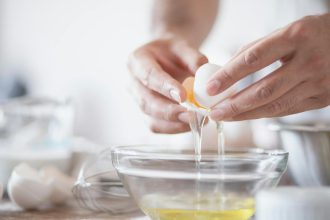Master 7 Egg Separation Techniques: Perfect Yolks & Whites Every Time!
Ever found yourself wrestling with a cracked egg, trying desperately to keep the yolk from mingling with the white? You’re not alone. Achieving a clean separation of egg whites and yolks is a fundamental skill in the kitchen, crucial for everything from fluffy meringues to rich custards. This guide dives deep into various egg separation techniques, transforming a potentially messy task into a confident culinary move. Let’s explore how to master this essential skill and elevate your cooking.
Why Mastering Egg Separation Techniques is a Game-Changer
The integrity of your egg components is paramount for many recipes. A single drop of yolk in your whites can prevent them from whipping into stiff peaks, while stray white in your yolk can alter the texture of a delicate sauce. Understanding effective egg separation techniques ensures predictable results and helps you achieve the perfect consistency every time. It’s about precision, control, and ultimately, better food.
Understanding the Basics: The Anatomy of an Egg
Before we dive into the ‘how,’ let’s quickly review the ‘what.’ A better understanding of an egg’s structure helps in successful separation:
- Egg white (albumen): Composed primarily of water and protein. Its unique protein structure allows it to foam when whipped, trapping air to create volume and lightness.
- Egg yolk: Rich in fats, vitamins, and minerals. The fat content is why even a tiny speck can compromise the whipping ability of egg whites.
Fresh eggs generally have firmer yolks and thicker whites, making them easier to separate. Older eggs tend to have runnier whites, which can make the process more challenging.
Essential Egg Separation Techniques for Every Cook
From traditional methods to clever kitchen hacks, there’s an egg separation technique for every skill level and situation. Here are some of the most reliable approaches:
1. The Classic Hand Method: Gentle and Effective
This is arguably the most tactile and controlled method, especially for larger quantities of eggs. With clean hands, simply crack the egg into your palm and let the whites slip through your fingers into a bowl below. The yolk remains safely in your hand.
Pros and Cons of the Hand Method
- Pros: Offers maximum control, no special tools required, works well for multiple eggs simultaneously.
- Cons: Can be messy, requires very clean hands to avoid contamination, potential for yolk breakage if not gentle.
2. The Shell-to-Shell Method: Traditional and Simple
A time-honored technique, this involves cracking an egg cleanly into two halves and gently passing the yolk back and forth between the shell pieces, allowing the white to drip into a bowl. This requires a steady hand and a clean break.
Tips for Success with the Shell Method
- Use fresh, cold eggs: The yolk membrane is stronger when cold, reducing the chance of breakage.
- Crack cleanly: Aim for a clean, even break around the egg’s equator to create two usable shell halves.
- Be patient: Don’t rush the process. Let gravity do its work as the white slowly separates from the yolk.
3. The Bottle Method: A Clever Kitchen Hack
For a surprisingly effective and mess-free approach, grab an empty, clean plastic water bottle. Crack your egg into a shallow bowl. Gently squeeze the bottle, place its opening over the yolk, and release the squeeze. The yolk will be suctioned into the bottle, leaving the white behind.
When to Use the Bottle Method
This method is fantastic for quick separations, especially when you need to separate several eggs without getting your hands messy. It’s particularly useful for those who find the hand method a bit too tactile.
4. Using Egg Separators: Specialized Tools for Precision
Various kitchen gadgets are designed specifically for egg separation. These range from simple plastic or metal scoops with slots to more elaborate designs that can separate multiple eggs at once. You crack the egg into the separator, and the whites drain through, leaving the yolk behind.
Choosing the Right Egg Separator
Consider ease of cleaning and material. Silicone or stainless steel options are durable and hygienic. Some separators are designed to hook onto the side of a bowl, making them hands-free.
Troubleshooting Common Egg Separation Challenges
Even with the best techniques, challenges can arise. Here’s how to handle them:
- Yolk breaking: If the yolk breaks and a piece contaminates the white, it’s best to discard that white if you need stiff peaks (e.g., for meringue). For other recipes where a little yolk won’t matter as much, you can try to carefully scoop out the yolk piece with a spoon or a piece of shell.
- Getting a clean separation: Ensure your bowls and hands are completely grease-free. Any fat residue can act like yolk, inhibiting whites from whipping properly.
Beyond the Basics: Advanced Egg Separation Tips
For truly superior results, consider these additional tips:
- Temperature matters: While cold eggs are easier to separate due to firmer yolks, egg whites whip best at room temperature. Separate them cold, then let the whites sit out for 20-30 minutes before whipping.
- One at a time: No matter the method, separate each egg into a small, separate bowl first. This way, if one yolk breaks, it doesn’t contaminate a whole batch of already separated whites.
- Freshness is key: As mentioned, fresher eggs separate more easily. Always check the date on your carton. For more on egg freshness, check out The Incredible Egg’s guide on egg safety.
Recipes That Demand Perfect Egg Separation
Many classic dishes rely heavily on precise egg separation techniques. Here are a few examples:
Meringues: Achieving Stiff Peaks
Whether for pie toppings, cookies, or pavlovas, meringues require absolutely yolk-free egg whites to whip up into their characteristic stiff, glossy peaks. Any fat from the yolk will prevent the proteins from forming a stable foam.
Custards and Crèmes: Smooth and Silky Textures
Recipes like crème brûlée, lemon curd, or hollandaise often call for yolks only. A clean separation ensures the rich, smooth texture and vibrant color without the added moisture or potential curdling from whites. Learn more about classic French culinary techniques at Le Cordon Bleu.
Conclusion: Master Your Kitchen with Confident Egg Separation
From the simple shell method to the clever bottle trick, mastering egg separation techniques is an invaluable skill for any home cook or aspiring chef. It’s about more than just separating two parts of an egg; it’s about understanding how ingredients behave and taking control of your culinary creations. With a little practice, you’ll be separating eggs like a pro, opening up a world of new recipes and perfect results.
Ready to elevate your culinary skills? Dive into your next recipe with newfound confidence!
Featured image provided by Pexels — photo by Pavel Danilyuk









